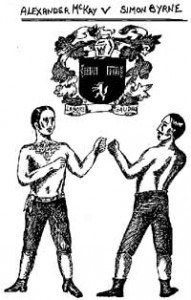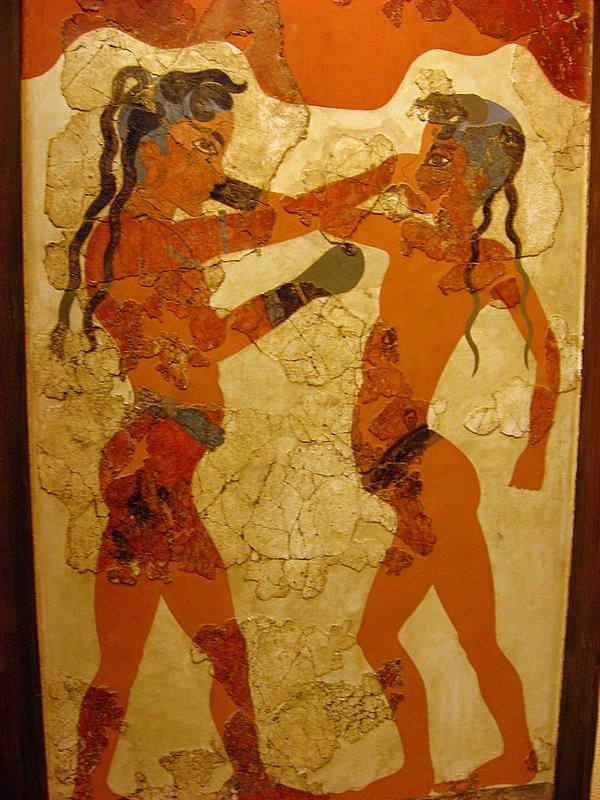Bare Knuckle Living
For some bare knuckle boxing is a savage bloodsport. Something the Marquess of Queensberry rules sought to refine and failed. For others, bare knuckle boxing is the truest form of combat between men. An ancient form of combat unlike no other steeped in tradition and culture.
For as long as there has been man there has probably been bare knuckle boxing. Different cultures all over the world practice this ancient sport in some form or other. The rules often vary but the outcome and goals are the same.
Greek mythology tells us that the Greek Hero Theseus invented a form of combat where two men would sit opposite each other and beat each other with their fists until one was dead. This developed into fighters standing and wearing gloves. Boxing became an Olympic sport in 688 BCE.

In Peru, an ancient festival called Takanakuy takes place every year on December 25th. Takanakuy translates as ‘The Blood Is Boiling’ in the Quechua language. It allows people the chance to solve their disputes with members of their community through violence. There are referees and all members of the community take part. Most men stick to bare knuckle boxing but kicking has been known to occur in the ladies match ups. If a downed opponent is struck the offender is whipped. The fighters hug before and after. As well as settling disputes Takanakuy mends cracks in the community.

Bare knuckle boxing dates back 3700 years in China, in fact, they only started wearing gloves 700 years ago. Modern or ‘western boxing’ was introduced in the 1920’s. Bare knuckle boxing was part of training introduced for soldiers during the late Shang Dynasty. By the Han Dynasty in 206 BCE – 220 CE bare knuckle boxing was mandatory training for soldiers.
During medieval Europe, the pursuits of ancient Greece and Rome diminished. More ‘noble’ activities such as jousting, archery and hunting entertained the aristocracy. In the 18th Century the ruling classes caught the boxing bug and as a result, it flourished.
James Figg was the first bare knuckle boxing champion of England. He won the title in 1719 and held onto it until he hung up his gloves in 1730. During Figg’s boxing career the rules were loose and differed from fight to fight. It was Figg’s protégé John ‘Jack’ Broughton who created a set of rules known as ‘The Broughton Rules’ in 1743. To put this in historical context the Battle of Culloden was in 1745! The Broughton Rules stated that around would last until a man was struck down and the break between rounds would be 30 seconds. These rules lasted for about the next 100 years and developed into the London Prize Ring Rules. In 1865 John Chambers drafted new rules which became known as the Marquess of Queensberry Rules due to the 9th Marquess of Queensberry, John Douglas endorsing the code.
A glance at the Marquess of Queensberry rules gives a glimpse as to the brutality that bare knuckle boxing could have entailed in 18 century Britain. The new rules showed that fighters must have regularly been beaten whilst helpless on their feet or on one knee then assisted to their feet for more of the same by their assistants and bottle bearers.

In June 1830, the Scottish Champion, Alexander McKay fought his Irish counterpart Simon Byrne in Hanslope. Now known as ‘The Fight at Salcey Green’ the fight resulted in the demise of McKay and the trial of Byrne for his death. Both men received £200 for the fight which is about £10,000 in today’s money. Byrnes trial demonstrated the strong support prizefighters had from the upper classes. Bryne was represented by three barristers and five solicitors. He was found not guilty after ten minutes of deliberation by the jury. Byrne himself died on the 1st of June 1833, a few days after a 99 round battle with the ‘deaf un’ James Burke.

On the 5th of July 1830, an Irishman and a Dundonian were discussing the fight between ‘Sandy McKay’ and ‘Symen Byrne’ in a Dundee bar and ‘from words proceeded to blows’. A fight ensued between a group of Scots and Irish outside and further descended into three days of rioting involving up to 18,000 people. A Catholic church was burned to the ground and looted, 200 wounded, and 3 dead. The military and 300 extra constables were sworn in to quell the riot.
In the modern era, bare knuckle boxing bouts between members of the Irish travelling community have come to the fore. Uploaded fights and ‘callouts’ on the internet give us an insight into this fascinating aspect of traveller life. Some videos are comical, others brutal.
Bare knuckle boxing has been used by the Irish travelling community to settle disputes for hundreds of years. There is no doubt that some disputes probably are settled this way however some are also settled by knives, guns and shallow graves. In the modern era, money plays a massive factor in Irish bare knuckle boxing with large sums changing hand and bets being placed. There is also a strong tradition of boxing in the Romany gypsy community as well.
The sound of these two squaring off is reminiscent of that iconic scene of Rocky Balboa punching hung beef.
The injuries a fighter can sustain in a bare knuckle boxing bout vary. From fractured jaws and eye sockets to broken fingers, hands and wrists. Because of this, the technique in bare knuckle boxing differs greatly from that of conventional boxing. There are 27 bones in the hand and punching someone’s skull is a sure fire way to break some of them. Quite often the heel of the hand is used instead of the knuckles. The outside wrist is used in an almost elbow like technique and modified hooks to hammerfists are also used. These are just a few many different techniques used in modern bare knuckle boxing.
For an ancient Greek, Irish Traveller or Peruvian fighting at Takanakuy bare knuckle boxing is a tradition and a way of life. But what would possess someone from a culture with no tradition in bare knuckle boxing to have a go?
Perhaps Tyler Durdem summed it up best. How much do you know about yourself if you’ve never been in a fight?

